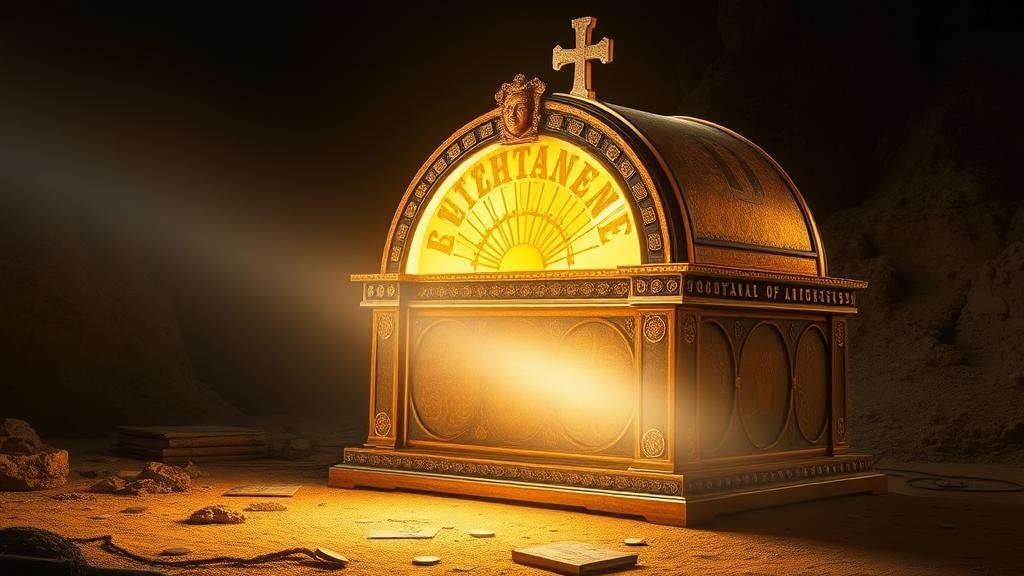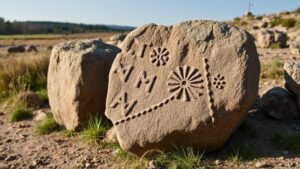Searching for the missing Ark of the Covenant, a relic of immense power and mystery.
Searching for the Missing Ark of the Covenant
The Ark of the Covenant, a sacred relic described in the Hebrew Bible, has captivated explorers, historians, and theologians for centuries. Constructed under the guidance of Moses, it is said to hold immense power and serve as a physical embodiment of God’s presence. But, its whereabouts have remained a mystery since the fall of Jerusalem in 586 BCE. This article delves into the historical significance of the Ark, theories surrounding its disappearance, and ongoing search efforts.
The Historical Significance of the Ark
The Ark of the Covenant is described in the Book of Exodus as a gold-plated wooden chest containing the stone tablets of the Ten Commandments, Aarons rod, and manna. According to Exodus 25:10-22, God commands Moses to create the Ark, which was to be carried by the Israelites during their exodus from Egypt and their journeys through the wilderness.
The Ark also held immense religious significance, believed to be a direct link between God and His people. It was housed in the inner sanctum of the Tabernacle, and later in Solomon’s Temple in Jerusalem. Its presence was thought to guarantee divine guidance and victory in battles.
Historical Context of the Ark’s Disappearance
The last confirmed sighting of the Ark was during the Babylonian siege of Jerusalem in 586 BCE. When the city fell, the Ark was either lost in transit, destroyed, or hidden away as a safeguard against the invaders. Historical records are sparse, which adds to the mystery surrounding its fate.
Several hypotheses challenge historians and archaeologists:
- It may have been taken to Babylon, as a trophy of conquest.
- Some believe it was hidden in the caves near Qumran, home to the famous Dead Sea Scrolls.
- Others speculate it was moved to Ethiopia, where the Ethiopian Orthodox Church claims to possess it in the Church of St. Mary of Zion, located in Axum.
Modern Expeditions and Theories
Numerous searches have taken place over the last century, driven by a mix of religious fervor and archaeological curiosity. One notable expedition was led by American archaeologist and filmmaker Simcha Jacobovici in 2010, which proposed that the Ark was hidden in a cave on the Temple Mount.
Also, in 2018, archaeologists excavating on Mount Nebo, the biblical site where Moses supposedly viewed the Promised Land, unearthed ancient artifacts that hinted at a possible connection to the Ark. Although no definitive evidence has surfaced, these findings provide a tantalizing glimpse into ongoing efforts to uncover the truth.
The Quest: Challenges and Considerations
The search for the Ark of the Covenant poses numerous challenges:
- Religious tensions: The sites considered for the Arks resting place often overlap with sacred religious locations, leading to conflicts.
- Political instability: Areas like Israel and Ethiopia face geopolitical issues that complicate archaeological efforts.
- Lack of concrete evidence: Many theories are founded on speculation rather than undeniable archaeological findings.
Also, critics argue that efforts to locate the Ark can be exploitative, prioritizing excitement over respect for cultural and religious sentiments. pursuit of the Ark is not merely an archaeological endeavor; it is a fight for cultural heritage.
The Ark’s Popularity in Culture
The intrigue surrounding the Ark of the Covenant extends beyond academia into popular culture. Films such as “Raiders of the Lost Ark†immortalized the idea of an adventurous search for the lost relic, fueling public interest and spawning conspiracy theories.
Plus, books ranging from the scholarly to the sensational continue to examine the Ark’s historical context, giving various interpretations of its significance. Debates often center around the implications of its rediscovery –whether it would validate religious texts or provoke conflict among faiths.
Conclusion: The Mystery Continues
The Ark of the Covenant remains one of history’s enduring mysteries. While countless theories and searches have yielded little concrete evidence, the quest continues to inspire a mix of religious devotion and archaeological curiosity. Its potential rediscovery could alter our understanding of ancient Israelite culture and practices, while also igniting theological debates.
For those intrigued by the mystery of the Ark, the journey holds as much significance as the destination. As research and exploration continue, both historical and modern perceptions of the Ark will evolve, perhaps bringing us closer to understanding this legendary relic.
Actionable Takeaways:
- Stay informed about ongoing archaeological excavations and discoveries related to the Ark.
- Engage with reputable historical texts and scholarly articles to gain a deeper understanding of the Arks background.
- Participate in discussions or forums that explore both the cultural and religious implications of such legendary artifacts.


